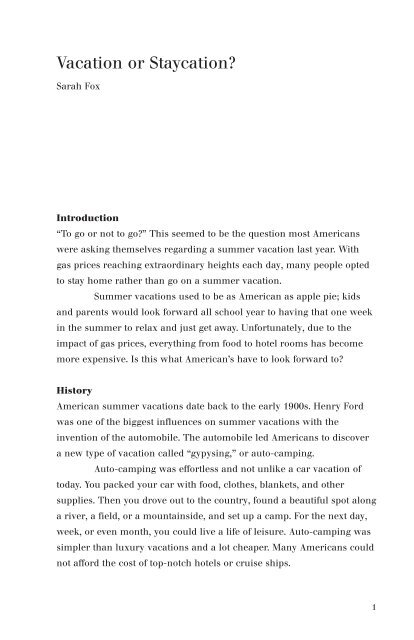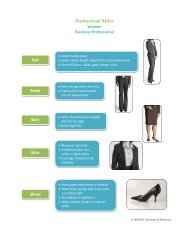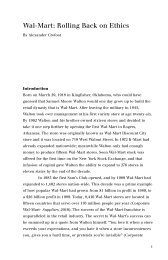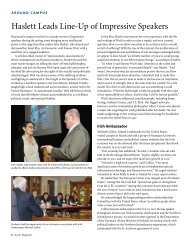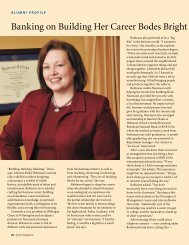Vacation or Staycation? - Neumann University
Vacation or Staycation? - Neumann University
Vacation or Staycation? - Neumann University
You also want an ePaper? Increase the reach of your titles
YUMPU automatically turns print PDFs into web optimized ePapers that Google loves.
<strong>Vacation</strong> <strong>or</strong> <strong>Staycation</strong>?<br />
Sarah Fox<br />
Introduction<br />
“To go <strong>or</strong> not to go?” This seemed to be the question most Americans<br />
were asking themselves regarding a summer vacation last year. With<br />
gas prices reaching extra<strong>or</strong>dinary heights each day, many people opted<br />
to stay home rather than go on a summer vacation.<br />
Summer vacations used to be as American as apple pie; kids<br />
and parents would look f<strong>or</strong>ward all school year to having that one week<br />
in the summer to relax and just get away. Unf<strong>or</strong>tunately, due to the<br />
impact of gas prices, everything from food to hotel rooms has become<br />
m<strong>or</strong>e expensive. Is this what American’s have to look f<strong>or</strong>ward to?<br />
Hist<strong>or</strong>y<br />
American summer vacations date back to the early 1900s. Henry F<strong>or</strong>d<br />
was one of the biggest influences on summer vacations with the<br />
invention of the automobile. The automobile led Americans to discover<br />
a new type of vacation called “gypysing,” <strong>or</strong> auto-camping.<br />
Auto-camping was eff<strong>or</strong>tless and not unlike a car vacation of<br />
today. You packed your car with food, clothes, blankets, and other<br />
supplies. Then you drove out to the country, found a beautiful spot along<br />
a river, a field, <strong>or</strong> a mountainside, and set up a camp. F<strong>or</strong> the next day,<br />
week, <strong>or</strong> even month, you could live a life of leisure. Auto-camping was<br />
simpler than luxury vacations and a lot cheaper. Many Americans could<br />
not aff<strong>or</strong>d the cost of top-notch hotels <strong>or</strong> cruise ships.<br />
1
To offset this trend and bring travelers back to them, motels<br />
became m<strong>or</strong>e like luxury hotels as owners added dining rooms,<br />
swimming pools, and air conditioning. The American vacation moved<br />
away from auto-camping, but the car and the family vacation were still<br />
completely connected. M<strong>or</strong>e recently, airplanes replaced automobiles,<br />
and ventures to Disney W<strong>or</strong>ld became the new American vacation<br />
(Summer vacation: Car camping, 2004).<br />
Reality Sets In<br />
The modern reality is gasoline prices peaked in the $4 per gallon range<br />
within the last year. Gas prices continue to frustrate mot<strong>or</strong>ists,<br />
impacting even the way people get to and from w<strong>or</strong>k. Naturally the<br />
recent hist<strong>or</strong>y of gas prices has people questioning whether <strong>or</strong> not it is<br />
w<strong>or</strong>th the additional expense to go on vacation. Average fourth-quarter<br />
airfare in 2007 was about $331 (Yu, 2008). By summer 2008, airfare had<br />
risen 16 percent, and was expected to continue to increase as the year<br />
progressed (US airfares up 16% in 2008; Expected to climb higher, 2008).<br />
This added a huge expense to anyone wishing to travel via airplane last<br />
summer, particularly given the airline practice of raising fares during<br />
the peak summer travel season.<br />
Airlines have also made a practice of adding new fees such as:<br />
$25 f<strong>or</strong> carry-on luggage, $25 f<strong>or</strong> any excess checked luggage (the third<br />
bag), $25 f<strong>or</strong> any luggage over 50 lbs, and a $50 fee f<strong>or</strong> oversized items<br />
(Southwest airlines baggage inf<strong>or</strong>mation, 2008). With all these additional<br />
fees added on to the cost of airline tickets, people reduced their travel by<br />
air significantly.<br />
As fuel prices rose, hotels and motels all across the country also<br />
raised their prices. Going local is not necessarily a money saver f<strong>or</strong><br />
travelers either. One example is the Caribbean Motel, a Wildwood, New<br />
Jersey retro inspired, basic hotel, can cost as much as $189 a night<br />
during peak time (Rooms and rates, 2008). That is m<strong>or</strong>e than a stay in<br />
Walt Disney W<strong>or</strong>ld’s All-Star res<strong>or</strong>t which starts at $89 a night (View by<br />
price, 2008). The result is that, whether local <strong>or</strong> at a distance, the family<br />
vacation has become significantly m<strong>or</strong>e expensive. Between food, fuel,<br />
2
housing and other miscellaneous expenses, even the simplest two-week<br />
beach vacation may cost in the thousands of dollars.<br />
<strong>Vacation</strong>s to m<strong>or</strong>e distant spots which require airplane travel,<br />
whether Disney W<strong>or</strong>ld <strong>or</strong> Chicago, have the same price point as the<br />
“simple” beach vacation because of airfare which makes up three<br />
quarters of the cost. With costs at such a high level and the state of the<br />
economy causing people to have trouble simply paying f<strong>or</strong> gas and<br />
putting food on the table, many res<strong>or</strong>ts and family vacation spots had<br />
reduced revenues last year and are likely to experience m<strong>or</strong>e of the<br />
same this year (Cultural Revolution, 2008).<br />
<strong>Staycation</strong> Haven<br />
<strong>Staycation</strong> is “a vacation that is spent at one’s home enjoying that entire<br />
home and [all] one’s home environs have to offer” (<strong>Staycation</strong>, 2008).<br />
With the price of gas soaring, a staycation was what many Americans<br />
experienced during the summer of 2008.<br />
A lot of cities recognized this, and started developing<br />
entertainment ideas that would allow people to feel like they were<br />
“getting away.” F<strong>or</strong> example, in Media, PA, there was a thirteen-week<br />
dining and entertainment extravaganza in which restaurants offered<br />
curbside dining accompanied by music from 5-10:00 P.M. once a week.<br />
This very popular event was called “Dining Under the Stars” and<br />
included free parking f<strong>or</strong> visit<strong>or</strong>s, scenic walking paths, shopping, and<br />
dining. The objective was to give people who were not going away f<strong>or</strong><br />
the summer, a place where it felt like they could get away f<strong>or</strong> a while.<br />
The public’s response was so great that m<strong>or</strong>e than 500 people showed<br />
up every Wednesday night (Carey, 2008).<br />
Many companies are jumping on the bandwagon to encourage<br />
the staycation as well, Wal-Mart as an example. “Cashing in on the<br />
‘staycation’ marketing and advertising campaigns given play in the<br />
media this spring, the retail giant has launched a ‘101 Days of Summer<br />
<strong>Staycation</strong>’ desktop widget offering tips on ways to enjoy the season<br />
without leaving home” (Fullwood, 2008).<br />
3
Wal-Mart began advertising this concept of “Summer<br />
<strong>Staycation</strong>” with an online tool that the user could download and access<br />
101 aff<strong>or</strong>dable, fun and family-friendly ideas to help an individual relax,<br />
celebrate and enjoy the special moments of summer in their own<br />
backyard (101 days of staycation, 2008). Other retailers, such as Sears<br />
and Macy’s, have long offered barbeque equipment, pool paraphernalia,<br />
and gear f<strong>or</strong> outside the customer’s home. The marketing eff<strong>or</strong>ts of Wal-<br />
Mart, along with these m<strong>or</strong>e traditional eff<strong>or</strong>ts of converting the<br />
backyard into the perfect location f<strong>or</strong> a family get-together, were<br />
designed to get people excited about the summer again, even one which<br />
does not include going on a real “vacation.”<br />
Others have put together special tips to help enhance a family’s<br />
staycation. Sardone put together a list of top ten staycation strategies.<br />
These tips included setting up a time and a date, putting out the “you are<br />
not welcome” mat, following a staycation budget, stocking up on games<br />
f<strong>or</strong> couples and families to play and using books, movies, photographs<br />
to transp<strong>or</strong>t the family to a different place (2008).<br />
Between the costs of going away, the new ideas related to what<br />
can be done while at home and the uncomf<strong>or</strong>table state of the economy,<br />
it makes m<strong>or</strong>e sense f<strong>or</strong> people to stay at home f<strong>or</strong> their summer retreat.<br />
In a “People Poll” conducted last summer in the Delaware County Times<br />
newspaper, Puglionesi conducted a survey asking “Are you considering<br />
a ‘staycation’ this year?” (2008). Out of the six people polled, three were<br />
going away, and three staying home. Though a very small sample, the<br />
reality it suggests is bigger. M<strong>or</strong>e and m<strong>or</strong>e people are deciding to stay<br />
home and staycation.<br />
The Economy<br />
F<strong>or</strong> years now, American middle class families have been squeezed by<br />
rising prices and shrinking take home pay (The state of the economy:<br />
2008, 2008). Acc<strong>or</strong>ding to Peterman (2007), American’s have little extra<br />
money to pay f<strong>or</strong> a vacation. Education costs have risen by over 60<br />
percent since the 2000-2001 academic year. Average tuition, fees and<br />
room and board costs at four-year, private universities have increased<br />
4
y $10,067, from $22,240 in the 2000-2001 academic year to $32,307 in<br />
the 2007-2008 academic year.<br />
Healthcare costs have skyrocketed and there are m<strong>or</strong>e<br />
uninsured Americans. The cost of family health insurance has risen 78<br />
percent since 2001. Meanwhile, the number of uninsured Americans<br />
has increased every year since President Bush took office, from 39.8<br />
million in 2000 to a rec<strong>or</strong>d high of 47 million in 2006. There has been a<br />
gigantic surge in energy costs. The rising costs f<strong>or</strong> gasoline, electricity<br />
and natural gas have devastated the budgets of middle class Americans.<br />
In 2008, the average household with children spent about<br />
$4,487 on transp<strong>or</strong>tation fuel costs, an increase of 136 percent <strong>or</strong> $2,584<br />
over 2001 costs (The state of the economy: 2008, 2008). The capricious<br />
housing market poses a threat to all Americans. Due in part to the<br />
irresponsible and v<strong>or</strong>acious m<strong>or</strong>tgage lending practices that have been<br />
allowed to thrive in recent years, the country is facing a m<strong>or</strong>tgage crisis<br />
that threatens not only the American dream of homeownership, but the<br />
entire domestic and international economy. F<strong>or</strong>eclosure rates are at<br />
rec<strong>or</strong>d levels and a new round of adjustable rate m<strong>or</strong>tgages are set to<br />
adjust in the near future, representing billions of dollars of already lost<br />
equity that could very well be followed up by even m<strong>or</strong>e losses<br />
(Peterman, 2007).<br />
There is the nightmare of declining incomes. America’s families<br />
are w<strong>or</strong>king harder and earning less today than they were at the start of<br />
the Bush Administration. Median household income, adjusted f<strong>or</strong><br />
inflation, has declined $962 from $49,163 in 2000 to $48,201 in 2006<br />
(The state of the economy: 2008, 2008). There is rec<strong>or</strong>d unemployment<br />
and fewer job opp<strong>or</strong>tunities at hand. In December 2007, the<br />
unemployment rate shot up to a two-year high of five percent, with nearly<br />
500,000 m<strong>or</strong>e Americans looking f<strong>or</strong> w<strong>or</strong>k than in the previous month.<br />
Private employers cut payrolls f<strong>or</strong> the first time in m<strong>or</strong>e than four years,<br />
and there was critical job losses in manufacturing, construction, financial<br />
services and retail sect<strong>or</strong>s. Since that time, unemployment has risen an<br />
additional 50 percent, GDP has fallen significantly and Wall Street<br />
volatility has cost American families billions of dollars in lost wealth.<br />
5
With all this and m<strong>or</strong>e impacting our economy today, it is not a great<br />
surprise that people simply do not have the money to spare f<strong>or</strong> a vacation.<br />
Conclusion<br />
To go on vacation <strong>or</strong> not may not be the most serious question faced<br />
by Americans in the current environment, but vacations have been<br />
a way of life f<strong>or</strong> Americans f<strong>or</strong> generations. In the last several years,<br />
the price of gasoline and m<strong>or</strong>e generally of transp<strong>or</strong>tation, had people<br />
questioning whether travel was necessary. M<strong>or</strong>e recently, as the<br />
economy has fallen apart, the idea of spending thousands of dollars<br />
f<strong>or</strong> a week <strong>or</strong> two seems even m<strong>or</strong>e unrealistic.<br />
<strong>Vacation</strong>s may seem like an unnecessary extravagance;<br />
staycations may offer the best possible alternative. Citizens are finding<br />
out what it is like to live paycheck to paycheck and thrift has become<br />
fashionable. Communities seem to be recognizing that their members<br />
might have a renewed interest in local events and attractions. While<br />
res<strong>or</strong>t areas will lose in the current environment, the new American<br />
n<strong>or</strong>m may be the staycation.<br />
References<br />
101 days of staycation. (2008). Retrieved: 8 June, 2008 from:<br />
.<br />
Carey, K. E. (2008, June 1). <strong>Staycation</strong> heaven. The Delaware County Sunday<br />
Times. p. 4-5.<br />
Cultural revolution. (2007). Economist. Retrieved 7 June, 2008.<br />
http://web.ebscohost.comehost/detail?vid=4&hid=103&sid=54acb3ff-fbf8-<br />
4c2e-Jeb1-abc2e6c3%440sesssionmgr103>.<br />
Fullwood, J. (2008, June 8). Air travel’s next outrage: Hold onto your seat.<br />
6<br />
The Sacramento Bee. Retrieved 8 June, 2008, from:<br />
.<br />
Peterman, D. Economy in trouble. Chicago Sun Times. Retrieved 8 June, 2008,<br />
from LexisNexis.
Puglionesi, L. (2008, June 3). People poll: Are you considering a ‘staycation’<br />
this year? The Delaware County Times. p.14.<br />
Rooms and rates. (2008, April 1). Retrieved 7 June, 2008, from<br />
.<br />
Sardone, S. B. Top 10 <strong>Staycation</strong> Strategies. Retrieved 8 June, 2008, from<br />
.<br />
Southwest airlines baggage inf<strong>or</strong>mation. (2008, January 29). Retrieved 7 June,<br />
2008. .<br />
<strong>Staycation</strong>. (2008). Retrieved 8 June, 2008, from .<br />
Summer vacation: Car camping. (2004). Retrieved 7 June, 2008,<br />
from WGBH Educational Foundation:<br />
.<br />
The state of the economy: 2008. (2008, January 25). Retrieved from The<br />
Democratic Policy Committee: .<br />
US airfares up 16% in 2008; Expected to climb higher. (2008, May 27).<br />
Retrieved 7 June, 2008, from .<br />
View by price. (2008). Retrieved 6 June, 2008. From The Walt Disney W<strong>or</strong>ld<br />
Website: .<br />
Yu, R. (2008, April 24). Airfares continue trend upward. USA Today.<br />
Retrieved 7 June, 2008, from USA Today website:<br />
.<br />
7


